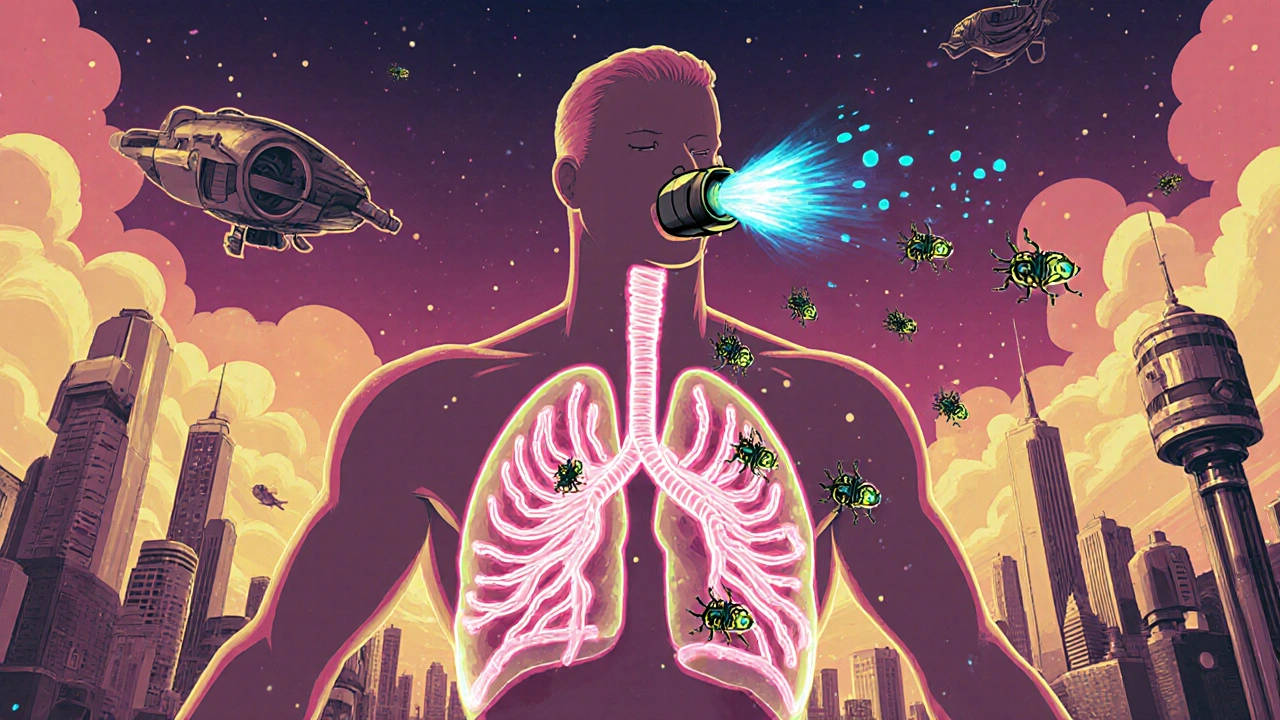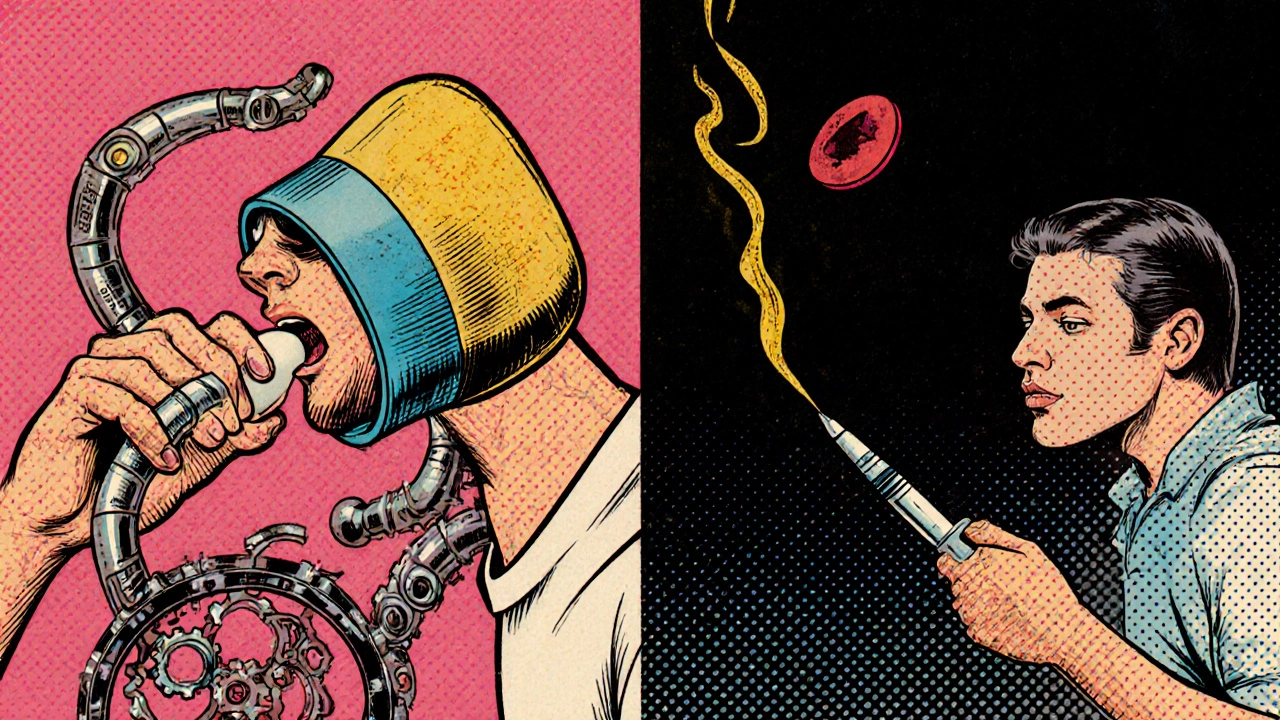Asthma Basics: Types, Triggers, and Inhalers vs. Oral Medications
 Nov, 16 2025
Nov, 16 2025
When you have asthma, breathing isn’t just something you do-it’s something you have to fight for. One minute you’re fine, the next, your chest feels tight, your lungs won’t expand, and every breath sounds like a whistle. It’s not just allergies or a cold. It’s asthma. And understanding it isn’t about memorizing medical jargon-it’s about knowing what’s happening in your body, what sets it off, and how to stop it before it takes over.
What Are the Main Types of Asthma?
Asthma isn’t one condition. It’s a group of conditions that all cause airway narrowing, but they start in different ways. The most common types are based on what triggers them and how your body reacts.Allergic asthma is the most common. It’s triggered by things like pollen, dust mites, mold, or pet dander. If your symptoms get worse in spring or around your cat, this is likely you. The immune system overreacts to these harmless substances, causing inflammation in the airways.
Exercise-induced asthma hits during or right after physical activity. You might feel fine walking around, but as soon as you start jogging or playing soccer, your throat closes up. Cold, dry air makes it worse. This isn’t just being out of shape-it’s your airways reacting to rapid breathing.
Occupational asthma develops from breathing in fumes, dust, or chemicals at work. Think bakery workers reacting to flour, factory workers exposed to isocyanates, or cleaners handling strong sprays. Symptoms often improve on weekends or vacations.
Cough-variant asthma doesn’t always wheeze. Instead, the only sign is a persistent dry cough-sometimes for weeks. It’s often misdiagnosed as bronchitis or post-nasal drip. If your cough doesn’t respond to antibiotics, asthma might be the real culprit.
Nighttime asthma strikes between midnight and 4 a.m. Lying flat, hormone shifts, and bedroom allergens like dust mites all play a role. Waking up gasping or coughing isn’t normal-it’s a red flag.
Then there’s steroid-resistant asthma, where standard inhaled steroids don’t help much. And aspirin-induced asthma, where NSAIDs like ibuprofen or aspirin can trigger a severe attack. These types are harder to manage and often need stronger treatments.
What Triggers Asthma Attacks?
Triggers aren’t the same for everyone. One person’s nightmare is another’s non-issue. But some triggers show up again and again.Outdoor allergens like pollen and mold spores spike in spring and fall. Indoor allergens-dust mites in bedding, pet dander on carpets, cockroach droppings-are constant threats. Smoke from cigarettes, fireplaces, or even incense can irritate airways. Cold air, especially when you’re breathing through your mouth during exercise, causes airways to tighten.
Respiratory infections like the common cold or flu are among the biggest triggers. Even a mild cold can turn stable asthma into an emergency. Stress and strong emotions-laughing too hard, crying, anxiety-can also cause airway spasms.
For some, chemicals in cleaning products, perfumes, or air fresheners are silent triggers. Air pollution, especially ozone and particulate matter, worsens symptoms in cities. And let’s not forget food additives like sulfites in dried fruit or wine, which can trigger attacks in sensitive people.
What’s dangerous is when triggers sneak up on you. You might not react to pollen one day, but after a sleepless night and a cold, the same pollen sets off a full-blown attack. That’s why tracking your triggers matters. Keep a simple log: what you did, where you were, what you ate, and when symptoms hit. Patterns emerge over time.
Inhalers: The First Line of Defense
If you’re on asthma medication, chances are you’re using an inhaler. They’re the most common and safest way to treat asthma because they deliver medicine straight to your lungs-where it’s needed-without flooding your whole body.There are two main kinds: rescue inhalers and preventer inhalers.
Rescue inhalers (like albuterol) are your emergency tool. They work in minutes to relax tightened muscles around your airways. You use them when you’re wheezing, short of breath, or feeling tightness. They’re not for daily use-if you need them more than twice a week, your asthma isn’t under control.
Preventer inhalers (usually inhaled corticosteroids like fluticasone or budesonide) reduce inflammation over time. You take them every day, even when you feel fine. They don’t give instant relief, but they stop attacks before they start. Studies show they reduce flare-ups by up to 70% compared to no treatment.
Many people now use combination inhalers that mix a long-acting bronchodilator (like formoterol) with a corticosteroid. These are used daily and also double as rescue meds in some cases. The 2023 GINA guidelines now recommend this approach even for mild asthma, because it cuts severe attacks by over 60% compared to using rescue inhalers alone.
But here’s the catch: most people use inhalers wrong. A 2023 study found 60-80% of users make at least one critical mistake-like not shaking the inhaler, not breathing in slowly, or not holding their breath after puffing. That means only 30-50% of the medicine actually reaches the lungs.
Use a spacer. It’s a plastic tube that attaches to your inhaler. It holds the medicine so you can breathe it in slowly and fully. Spacers are especially important for kids and during attacks. They boost delivery by up to 50% and reduce throat irritation.

Oral Medications: When Inhalers Aren’t Enough
Oral medications are not the first choice. They’re the backup plan. Why? Because they affect your whole body, not just your lungs.Oral corticosteroids like prednisone are powerful anti-inflammatories. Doctors use them for severe flare-ups-when you’re in the ER or can’t breathe even after using your inhaler. A short 3-5 day course is safe and effective. But if you’re on them every few months, or long-term, the side effects pile up fast.
Long-term use causes weight gain (68% of users), bone thinning (30-50% higher fracture risk), high blood sugar (5-10% develop diabetes), mood swings, and insomnia. One Reddit user wrote: “I gained 8 pounds in two weeks. I couldn’t sleep. I cried for no reason. I wouldn’t wish this on my worst enemy.”
Leukotriene modifiers like montelukast (Singulair) are oral pills taken daily. They block chemicals that cause airway swelling. They’re often added to inhaled steroids for people whose asthma isn’t fully controlled. They’re less risky than steroids, but not risk-free-some report mood changes or sleep issues.
For severe asthma, especially if it’s driven by high eosinophils (a type of white blood cell), biologics like mepolizumab (Nucala) or tezepelumab (Tezspire) are injected monthly or every few weeks. These target specific inflammation pathways. In trials, they cut asthma attacks by 50-60%. They’re expensive, but for some, they’re life-changing-replacing monthly steroid bursts with a simple shot.
Why Inhalers Beat Oral Meds for Most People
Doctors push inhalers because they work better and are safer. Think of it like this: if your car is making a noise, you don’t replace the whole engine-you fix the spark plug. Inhalers fix the problem at the source.Oral steroids flood your body with hormones. They’re like using a sledgehammer to crack a nut. Inhalers are the precision tool. They deliver the same medicine, but 90% of it stays in your lungs. That means fewer side effects, faster relief, and better long-term control.
According to the NIH and GINA, regular oral steroid use for maintenance is no longer recommended. It’s too risky. Inhalers, especially combination ones, are now the standard for almost all asthma types.
But cost is a real barrier. Brand-name inhalers can cost $300-$400 a month without insurance. Generic oral meds? $10-$30. That’s why 25% of U.S. asthma patients ration their inhalers-skipping doses to make them last. That’s dangerous. Under-treating asthma leads to ER visits, hospital stays, and permanent lung damage.
There are options: ask for generics, use mail-order pharmacies, check patient assistance programs from drugmakers, or switch to a generic combination inhaler like fluticasone-salmeterol (Advair) or budesonide-formoterol (Symbicort). Many insurers cover them at low copays.

What About New Treatments and Tech?
Asthma care is getting smarter. Smart inhalers now have sensors that track when and how you use them. Apps sync with your phone to remind you, show you your trigger patterns, and alert you when pollution is high. One 2023 study found users improved adherence by 35% and had 22% fewer attacks after 12 months.Biologics are expanding too. Tezepelumab works even if you don’t have high eosinophils-meaning it helps more types of severe asthma than older drugs. And research is moving toward personalized treatment: blood tests to identify your asthma’s exact inflammation type, then matching you to the best drug.
But access is still unequal. In low-income countries, 80% of asthma cases go untreated because inhalers are too expensive or hard to find. In the U.S., even with insurance, copays can be a burden. The answer isn’t just better drugs-it’s better access.
What Should You Do Next?
If you have asthma:- Know your type. Is it allergic? Exercise-induced? Nighttime?
- Track your triggers. Write them down for a month.
- Use your inhaler correctly. Ask your doctor or pharmacist to watch you use it.
- Use a spacer. Always.
- Don’t skip your preventer inhaler-even when you feel fine.
- Don’t rely on oral steroids for daily control. They’re for emergencies only.
- If you’re on oral steroids often, ask about biologics or other add-ons.
- Get a peak flow meter. It tells you if your lungs are starting to narrow before you feel it.
Asthma doesn’t have to control your life. With the right tools and knowledge, most people live full, active lives-without constant symptoms or hospital visits. The key isn’t finding the perfect drug. It’s understanding your body and using what works, safely and consistently.

Peter Stephen .O
November 17, 2025 AT 00:06Man I used to think asthma was just wheezing until I saw my cousin go full Hulk mode during a soccer game-no warning, just gasping like a fish on pavement. Turns out it was exercise-induced and he was just ‘out of shape’ according to his coach. Spacers changed his life. I didn’t even know they existed until he showed me. Now I nag my whole family to use them. Seriously, if you’re not using one, you’re wasting half your meds. It’s not fancy, it’s just science.
jalyssa chea
November 18, 2025 AT 01:13why do people even use inhalers anymore i mean like the pills are cheaper and you dont have to remember to shake them or hold your breath or whatever its just take a pill and forget about it like why make it so complicated i dont get it
Julie Roe
November 18, 2025 AT 09:57Hey jalyssa, I get why pills sound easier-no coordination, no technique, just swallow and go. But here’s the thing: oral steroids aren’t just ‘pills,’ they’re systemic grenades. They flood your whole body with hormones, wreck your sleep, make you gain weight, and thin your bones. One friend went on prednisone for two weeks and cried for no reason for months after. Inhalers? They’re targeted. Like a sniper rifle vs a shotgun. The medicine goes where it’s needed. And yeah, spacers are weird-looking but they’re basically free upgrades. Ask your pharmacist to show you how to use it-most will do it for free. You’re not being lazy, you’re just not trained yet. And that’s fixable.
Joyce Genon
November 19, 2025 AT 16:49Okay but let’s be real-GINA guidelines are written by people who’ve never had to pay $400 for a blue inhaler while working two jobs. My cousin’s mom has to ration hers. She uses one puff every other day because the prescription doesn’t cover the generic combo. And yeah, she’s had two ER visits this year. So don’t give me the ‘inhalers are better’ lecture when the system is designed to make you fail. Biologics cost more than a car payment. This isn’t about medical superiority-it’s about capitalism pretending it’s healthcare. The real trigger isn’t pollen-it’s the insurance company’s deductible.
And don’t even get me started on ‘smart inhalers.’ Yeah, cool tech. But if you can’t afford the inhaler, you sure as hell can’t afford the app subscription. They’re selling wellness as a SaaS model now. Asthma isn’t a problem to be optimized-it’s a condition to be managed while you’re drowning in bills.
And yes, I know I’m being a toxic analyst. But someone’s gotta say it. The medical industry profits off your breath. That’s not conspiracy-that’s quarterly earnings reports.
Andrew Cairney
November 19, 2025 AT 23:23EVERYONE KNOWS THE PHARMA COMPANIES CONTROL THE GINA GUIDELINES. THEY MADE INHALERS EXPENSIVE ON PURPOSE SO YOU’D BE FORCED INTO LONG-TERM ORAL STEROIDS WHICH THEY OWN THE PATENTS FOR. I SAW A DOCUMENT LEAKED ON 4CHAN LAST YEAR-IT SHOWED A MERCK EMAIL SAYING ‘INHALER COMPLEXITY DRIVES ADHERENCE ISSUES WHICH INCREASES REPEAT SALES.’ THEY WANT YOU TO USE THEM WRONG. AND SPACERS? THEY’RE NOT EVEN COVERED BY MEDICAID IN 12 STATES. THAT’S NOT AN ACCIDENT. THEY WANT YOU TO GET SICK AGAIN SO YOU’LL NEED MORE DRUGS. THE CDC IS IN ON IT. I’VE GOT THE SCREENSHOTS. 🤫👁️
Rob Goldstein
November 21, 2025 AT 10:47Andrew, I hear your frustration-but the data doesn’t support a conspiracy. Biologics are expensive because they’re monoclonal antibodies grown in bioreactors, not pills made in a factory. The real issue is supply chain and patent cliffs. But here’s what’s actually happening: newer generics like fluticasone/salmeterol are now under $30 with coupons. And the FDA just approved a biosimilar for mepolizumab next year-price will drop 70%. Smart inhalers? They’re being piloted in Medicaid clinics with zero out-of-pocket cost. It’s slow, but it’s real. You’re not wrong to be angry-but the solution isn’t paranoia, it’s advocacy. Call your rep. Push for the Asthma Access Act. The system’s broken, but it’s fixable if we push together.
Gary Lam
November 21, 2025 AT 10:51Yo I’m from Singapore and we’ve got this thing called ‘asthma clinics’ where you walk in, get a free spacer, and a nurse watches you use your inhaler for 5 mins. No charge. No insurance needed. Meanwhile in the US you gotta fight a robot to get a $20 copay. I mean… we’re all breathing the same air, right? Why is your lung health a luxury? Just saying.
vinod mali
November 21, 2025 AT 18:48i use inhaler daily and spacer too. my dad had asthma in india and he used to buy one puff from local shop when he felt bad. no doctor. no prescription. just a small metal can. now i have access to everything but still forget sometimes. so i set phone alarm. its not about money or conspiracy. its about remembering to care. small things matter.
John Wayne
November 22, 2025 AT 23:35Interesting how the article casually dismisses oral steroids as ‘sledgehammers’ while ignoring that inhaled corticosteroids are just delayed-release oral steroids with a delivery mechanism. The pharmacokinetics are nearly identical. The ‘precision tool’ narrative is marketing, not medicine. And the GINA guidelines? Written by a panel with 80% financial ties to inhaler manufacturers. This isn’t science-it’s branded ideology dressed in clinical language.